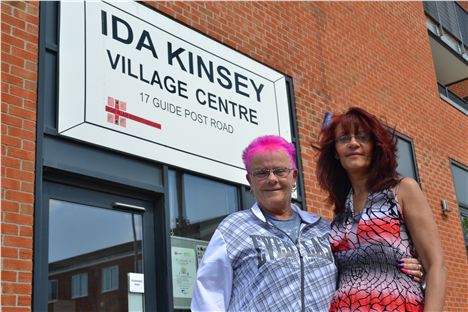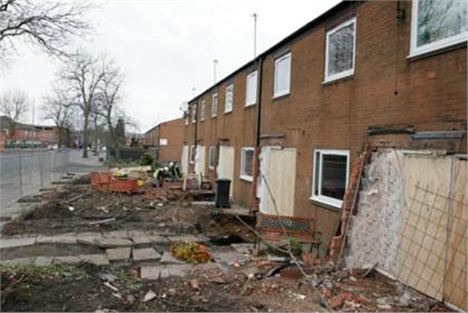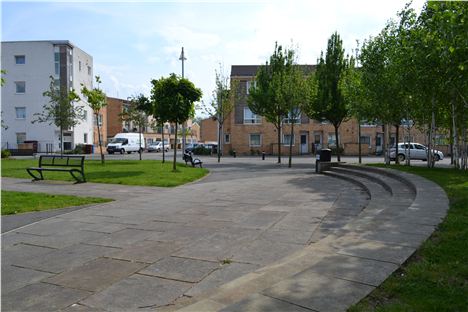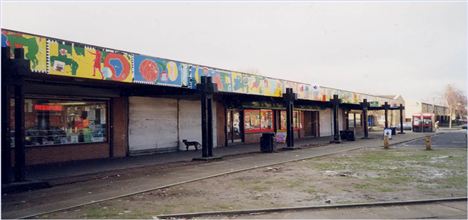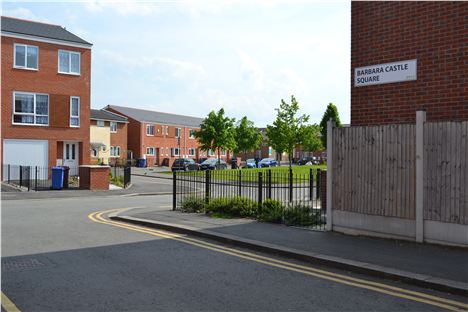IN the 1990s Plymouth Grove was a place of last resort. Poor housing, high crime, high unemployment and social deprivation. The solution was the country’s first Housing PFI – a controversial solution demolishing hundreds of homes to make way for new private housing which funded repairs to existing stock with on-going intensive management of the estate. Brunswick has just begun a similar process.
Ten years on this is the peoples’ story of the making of Grove Village.
Former Lord Mayor, Councillor Mavis Smitheman has represented Ardwick for 11 years and is a member of The Grove Village steering group.
“Has it been a success? Oh God yes! They come from all over the country, to have a look.
“No-one likes change and at first it looked like a building site and people were unhappy. But overall once change started and they saw the new kitchens and the new bathrooms, whole rows given new windows and new roofs, then they realised the change was positive.
“Attitudes changed. So we changed the name and people are proud to live in Grove Village now.”
Grove Village - Ex-Lord Mayor, Councillor Mavis Smitheman and Tina Hewitson
Martin Oldfield, Head of Housing at Manchester City Council –
“The residents need the biggest praise. They came to the City Council and the officers, saying: ‘You have to do something with this estate. You need to get rid of the crime and anti-social behaviour.’
“It was that pressure from the residents that was the catalyst for change, they drove the city to come up with a radical solution and get the best possible outcome.
“We looked at stock transfers and Pathfinder and if there was a new idea around and some cash attached to it we would apply for.
“But at Plymouth Grove we had to change the nature of the estate. When we offered Right to Buy to the 1,100 tenants only 50 people applied. Few were prepared to invest in where they lived.
“So the solution was radical: 500 properties - 40% of the estate – were demolished and people were re-housed. Half the people chose to stay, half to go somewhere else.
“The major refurbishment work to the remaining properties was done in three years and one of the lessons we learned was that we tried to do things too quickly. There was massive disruption for residents. The product at the end was brilliant but the first three years were very hard.
“Gleeson built and sold much faster than they had forecast because of the boom. It slowed down from 2008-2010 and the residents agreed to let them ease off and stop building but it’s going ok again now.
“The estate is still very intensively managed. Your Housing delivers the service very well but hopefully that means we specified it right in the first place. Ten years in and it still looks very good.
“It was a long process to get there, cost a lot of time and effort on everyone’s part but the results are plain to see.
“Would we have been quite so radical and would the outcome have been quite so good if we had just done it ourselves? I don’t think so.”
Anne O’Malley – led one of the two residents associations in the area and joined the steering group.
“It was a bad place to live back then. We had 20 murders in a two mile area. For the youngsters it was like growing up in Beirut, the sound of gun fire all the time.
“Despite that it was a good community but we were haemorrhaging people. They were scared.
“The two residents associations started having joint meetings on the quiet. This was where we lived and we wanted to make it better.
“We ambushed a meeting that was supposed to say how good MANCAT was. We printed leaflets and delivered them at night and took photos of the steeled houses and the state of the streets and made a board showing what the estate really looked like.
“There were loads of people there and when the press came we unfurled our board and there was a big fuss. They tried to censor us but we stood on the tables and shouted that we wanted something done.
“We felt we had been abandoned and the only thing to do was fight.
“We agreed to meet the council and someone mentioned PFI. The two residents associations came together and we formed a steering group and spent the next seven years trying to get something done.
“For seven long, solid years we stuck it out, meeting in the freezing Neighbourhood Office, two or three times a week.
“People got ill, marriages broke up, friends fell out. We lost Ida.
“It was tough.
“I have lived in the same house for 40 odd years, I took it over from my parents. We asked to be decanted while the work went on but they said it wasn’t needed so we lived through it. We camped out upstairs while they ripped out the kitchen and had no windows or doors. The dust and mess was awful.
“We were the guinea pigs. We used to go and clean up for the elderly people because they couldn’t and it upset them to see their home dirty.
“We nearly didn’t get the community centre. We went to Harvest Housing as it was then and we begged for it and they found the money. We thank Ian Perry for that – a big man with a big heart.
“The Ida Kinsey Centre has a little bit of each of us in there, including people from the council.
“It was built on tears of despair and frustration and anger and loss and then joy when the thing got signed.
“We want the project to be finished now. We don’t like having fenced off bits of land and want Gleeson to get on with it and leave.
“The community has shifted and changed. People move on, new people move in. It’s still very diverse and multicultural and new bonds are being made. Things like Britain in Bloom help – we involve everyone, the school kids, the teenagers, and it makes the place look lovely. All the flowers.
“Of course it’s a much better place than it was. There’s a waiting list to live here and while nobody ever gets completely what they want when you look around I think we came close.”
Steve Rumbelow was acting Director of Housing for Manchester at the start of the PFI.
“I always had the view that from UK PLC’s financial point of view PFI may leave a lot to be desired but from Manchester and Ardwick’s position it was pretty much the only game in town.
“At the time Manchester had 70,000 council homes, most of which needed significant investment and Plymouth Grove also had significant social challenges. The solutions we were applying elsewhere, stock transfer for instance, would not work there.
“It became the first housing PFI in the country. It was incredibly complicated to do the deal, not least because the rules about it were still being worked out with Government.
“There had to be a will to make it happen. It was a very complicated project that we had to get over the line because the prize on offer, the transformation of a huge estate, was worth it.
“There was a lot of community involvement which was testing at times but which led to a better result in the end. Three very good local councillors who got the deal done but on terms that worked for the local community.
“It was tricky and there were wobbles along the way. We had some feisty sessions and the procurement process took a look long time, you have to have people who are stickers.
“But there are some fairly special people down there, they came together in a way that was challenging but they knew they had to work together.
“There were casualties along the way, difficult setbacks, but underneath there was a strong tough, robust core that had the resilience to get through the difficult process and engage with friends and neighbours and take enough people with them.
“The change is enormous, it’s a vibrant urban village now and I am very proud of what has been achieved."
The tidied up Grove
Tina Hewitson (main picture above), a mother of four, was part of the founding group and is now a local ward councillor, elected in 2012.
“Its 25 years since I went to a residents meeting and put my hand up saying I wanted to help. I can’t believe it’s that long.
“I was just a mother who had moved here with young children and who was afraid to go out at night. There were drug dealers at the back door and shootings and we needed change.
“It was a steep learning curve for us all. We were ordinary people being asked to look at tenders and consortium bids and really complex documents and ideas and decide what we wanted.
“Sometimes we were meeting every night, people were exhausted. But we had to be strong and stand up and fight for what we thought the community wanted.
“We signed confidentiality agreements so we were not able to say which properties would be coming down. We lived in my partners’ house and I could not even tell him it was one of the ones being demolished.
“It split us up, he saw it as betrayal that I did not tell him. But I’d signed.
“There was a lot of upheaval. My elderly neighbour took it badly and died in the move. It was too much for him and there were some very bad moments.
“But good ones too. The children were young and just excited about getting a new home. We moved to a house at the other end of the estate that had been refurbished.
“I recently went to meet the tenants at Brunswick who are just starting their own PFI to say what it is going to be like. Not as a councillor but as a mother and tenant. I have warned them it will be tough.
“At first it is just mud and bricks and rubble and mess and you cannot see the end – only the beginning.
“But then it does end and you look round and you say WOW!
“Grove Village is one of the cleanest estates in Manchester now, it is very intensively and positively managed and people respect that. The park is not vandalised and there is no rubbish around. And we have a lovely new shopping precinct.
“People were worried saying the demolition would split the community but in fact it has all come together.
“The Ida Kinsey centre is busy every hour of the day with activities and groups and we put on our own pantomime and run pensioners’ holidays and take kids on a camping trip for a week and they love it.
“The PFI helped do that – it saved the estate and the community.”
Dave Tomlinson is chair of Grove Village residents association.
“Twelve years ago I didn’t really understand what they meant about regeneration and I suspect a lot of other people didn’t either. There was a mystical phrase, ‘sustainable community’ which I never understood either, but not signing up to a sustainable community was like accusing people of witchcraft.
“But ten years on I actually have got a fairly decent grip on what sustainable community means.
“It is one which has various demographics, various property types, varied people profiles. A central area where people can get help and information irrespective of their background, which has a commercial centre where people can safely go for a bottle of milk after dark and a community centre offering all sorts of activities. Perhaps with employment and leisure.
“All these things have come together at Grove and given us what that elusive intention was - a modern local village.”
Improvements in Grove
Ian Perry was chief executive of Harvest Housing and is chairman of the Grove Village Board
“Plymouth Grove had become a place where people did not choose to live. It was a neighbourhood of last resort. Despite this, it still housed people who had lived there a long time and for whom it was home.
“It was obvious that a radical transformation was necessary - something which would change the environment as well as the housing. Management of the area also needed a major upgrading. This analysis led Manchester City Council to choose the PFI solution and get Plymouth Grove included in the first round of Housing Revenue Account (HRA) pathfinders.
“We knew that design improvements alone would not be enough - we had seen enough failed Estate Action schemes where investment had been wasted because it ignored community needs and was not accompanied by an improved management regime. With a 30 year contract it is essential that change is sustainable. This is one of the internal strengths of PFI.
“Delivering change is all about people and the players involved at Grove got on really well from the start. But I do still remember walking round and asking: ‘Do you think it will work?’ We did not really know what we were getting in to.
“Our vision was for a managed village, a safe, clean, secure environment and to get there we needed both financial and social change.
“500 properties were demolished and replaced with 700 new ones. We could have put a road down the middle with rent on one side and private on the other but it is properly integrated between rent and sale.
“The shopping centre was horrific and taking that away was an essential part of the plan. We consulted with the residents, talked them through a physical map of the estate and we spent a lot of money on infrastructure which you don’t notice now as it just looks normal.
“On April Fool’s Day, 2003, the Grove Village company took over the running of the estate and it will run it till 2033.
“Experts are interested in how you can transform local authority areas and the long term sustainability of that change and the longevity of Grove will be the key. It is a long term solution, not a quick fix.
“We have costed right up to Year 30, to provide the same level of service that is being provided at the moment. It will be handed over in Year 30 as good as it was in Year 5.
“We have no problem with the very high standards determined by the city council. We have more staff per property at Grove than anywhere else but we are being paid for it. The issue for the city is that the rest of its housing stock should get similar service.
“Being first at anything is hard work but we showed that Housing PFI does work and ten years on I am very proud of what has been achieved – bursting with it."
Stephanie Hewitson took the pictures of the refurbished estate.
The greening of Grove









